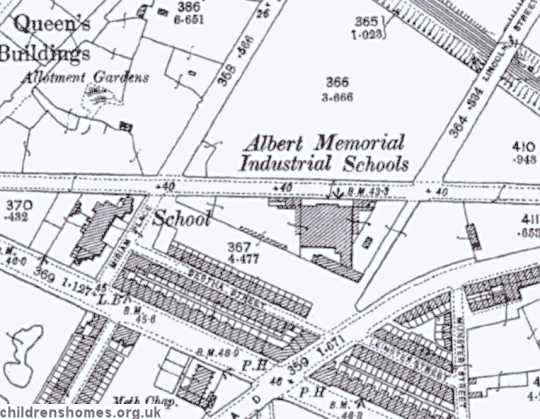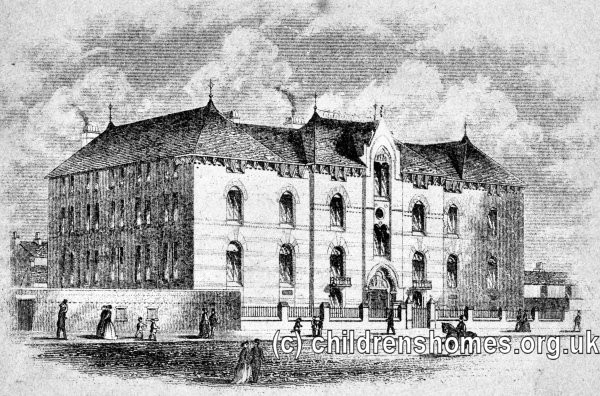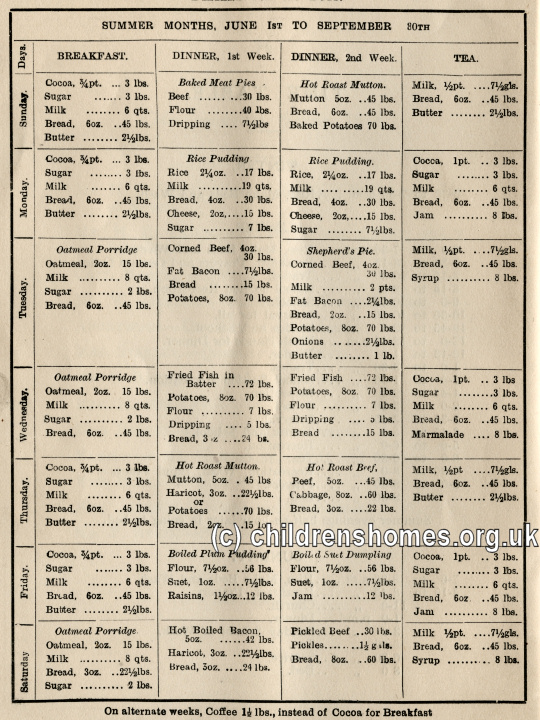Albert Memorial Industrial Schools for Boys and Girls, Birkenhead, Cheshire
The Albert Memorial Industrial Schools, also known as the Birkenhead Ragged and Industrial Schools, were founded in 1863 as a tribute to the late Prince Albert who had died in December 1861. The Schools mainly owed their existence to William Jackson, a wealthy industrialist and the Member of Parliament for Newcastle under Lyme, who had grown up in Birkenhead. Jackson proposed the erection of an establishment for the lodging, boarding and industrial teaching of one hundred destitute children, towards which he would donate £5,000 and the site, a plot of land that he owned on Corporation Road, Birkenhead.
While a permanent building was under construction, the Schools occupied temporary premises on Hamilton Street, where some twenty-five children were lodged, together with fifty who attended as day-scholars and were also fed. The working expenses of the school and maintenance of the children were funded by public subscription. The Schools were managed by a committee chaired by Mr Jackson. On December 22nd, 1863, the premises were officially certified as an Industrial School, allowing them to receive children who had been committed by the courts to a period of detention.
An inspection report in June, 1865, found that 20 boys and 10 girls were boarded at the establishment, all but one being voluntary inmates, and some being paid for by friends. As well as basic education, the boys were taught tailoring and shoemaking, while the girls learned needlework, housework, washing etc. The staff comprised the master, Mr Monkman Bielby (or Beilby), and his wife Fanny, a servant, and a tailor and shoemaker who attended for two or three hours each day.
Designed by David Walker, the building cost £8,000 and its construction was completed in November 1865. It included a boys' school room, 57 feet long by 20 feet wide, a girls' school room, 32 feet long, a dining hall 29 feet by 35 feet, dormitories, a board-room, classrooms, teachers' rooms, baths, and covered playgrounds. A detailed description of the building was published in 1866:
For legal reasons, the official opening of the Schools and the formal handing over of the site to a Board of Trustees was delayed until October 25th, 1866. The new premises were certified for use as an Industrial School on February 14th, 1866, with accommodation for 150 children, aged 8 to 14 years at their admission.
The Corporation Road site is shown on the 1899 map below.

Albert Memorial Industrial School site, Birkenhead, c.1899.

Albert Memorial Industrial School, Birkenhead, 1865. © Peter Higginbotham
An inspection in October, 1866, found just over 100 children present, of whom 90 were lodged and boarded on the premises and around a dozen day-scholars. The inspector commented that the location of the Schools, on the outskirts of the town, made it difficult for day-scholars to attend, and that the teachers also had to be resident, which caused expense and difficulties. All the clothing used in the Schools was now made by the children. The work undertaken by the boys now included baking and wood-cutting.
Mr Bielby continued as superintendent until his death in January, 1896. The Bielby's were succeeded by Mr R. Blakeboro, schoolmaster for the previous ten years, and Mrs Blakeboro.
An inspection report in 1896 described the School building as gloomy, with the windows being small and badly placed. The boys' upper dormitory was overcrowded, and the sick-room miserable. The boys were provided with some gymnastic apparatus, but no regular gymnastic instruction. However, a good playing field had been acquired in front of the School and football and cricket matches were played with outside teams. The boys were taken to the river shore for bathing and had had a day trip to Rhyl. The girls had some small garden plots to tend. Various entertainments were organised during the winter. The School library contained 300 books. The inspector suggested that the girls at the School be removed to their own separate establishment. This suggestion was put into practice and the School was recertified for the accommodation of 120 boys on March 1st, 1899. The girls in residence at the time were distributed amongst other institutions.
In July, 1899, Mr and Mrs Thomas Paterson took over as superintendent and matron. Following the death of Mrs Patterson in July, 1914, her daughter Daisy was appointed as matron, having assisted her mother in the work for some time previously.

Albert Memorial Industrial School, Birkenhead, c.1900. © Peter Higginbotham
The 1914 weekly summertime menu plan, giving the amounts allocated for 120 boys, is shown below.

Albert Memorial Industrial School Dietary, Birkenhead, 1914. © Peter Higginbotham
Due to falling numbers being placed at the School, it was closed in April, 1924.
The premises were later occupied by the Cleveland Works. Housing now covers the site.
Records
Note: many repositories impose a closure period of up to 100 years for records identifying individuals. Before travelling a long distance, always check that the records you want to consult will be available.
- None identfied at present — any information welcome.
Census
Bibliography
- Higginbotham, Peter Children's Homes: A History of Institutional Care for Britain's Young (2017, Pen & Sword)
- Mahood, Linda Policing Gender, Class and Family: Britain, 1850-1940 (1995, Univeristy of Alberta Press)
- Prahms, Wendy Newcastle Ragged and Industrial School (2006, The History Press)
Links
- None noted at present.
Except where indicated, this page () © Peter Higginbotham. Contents may not be reproduced without permission.


